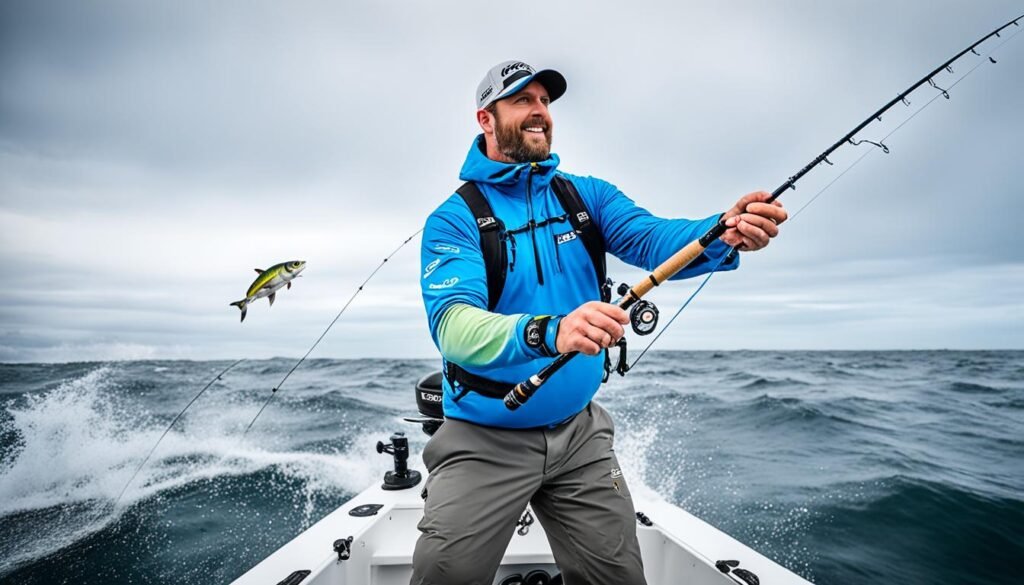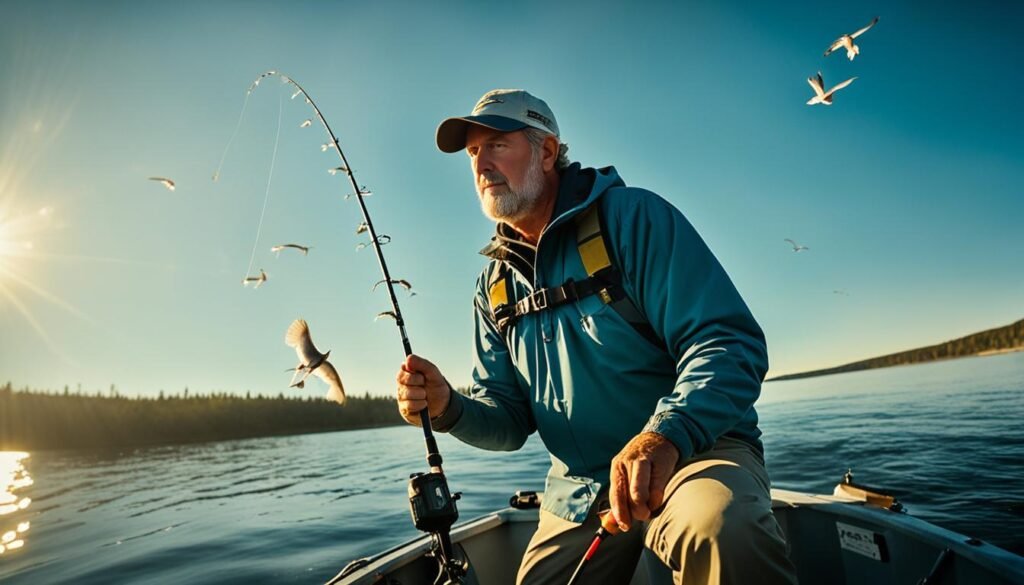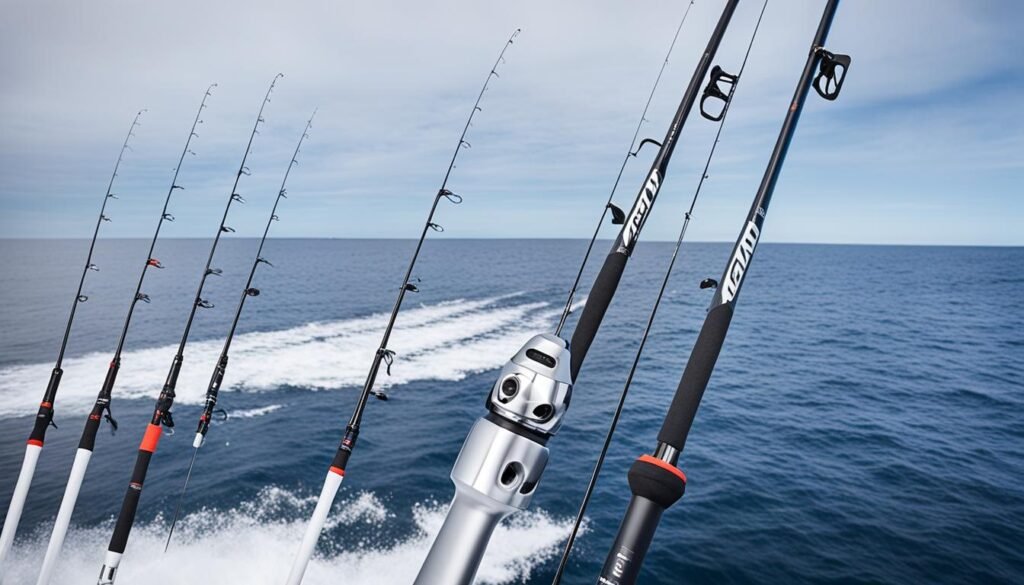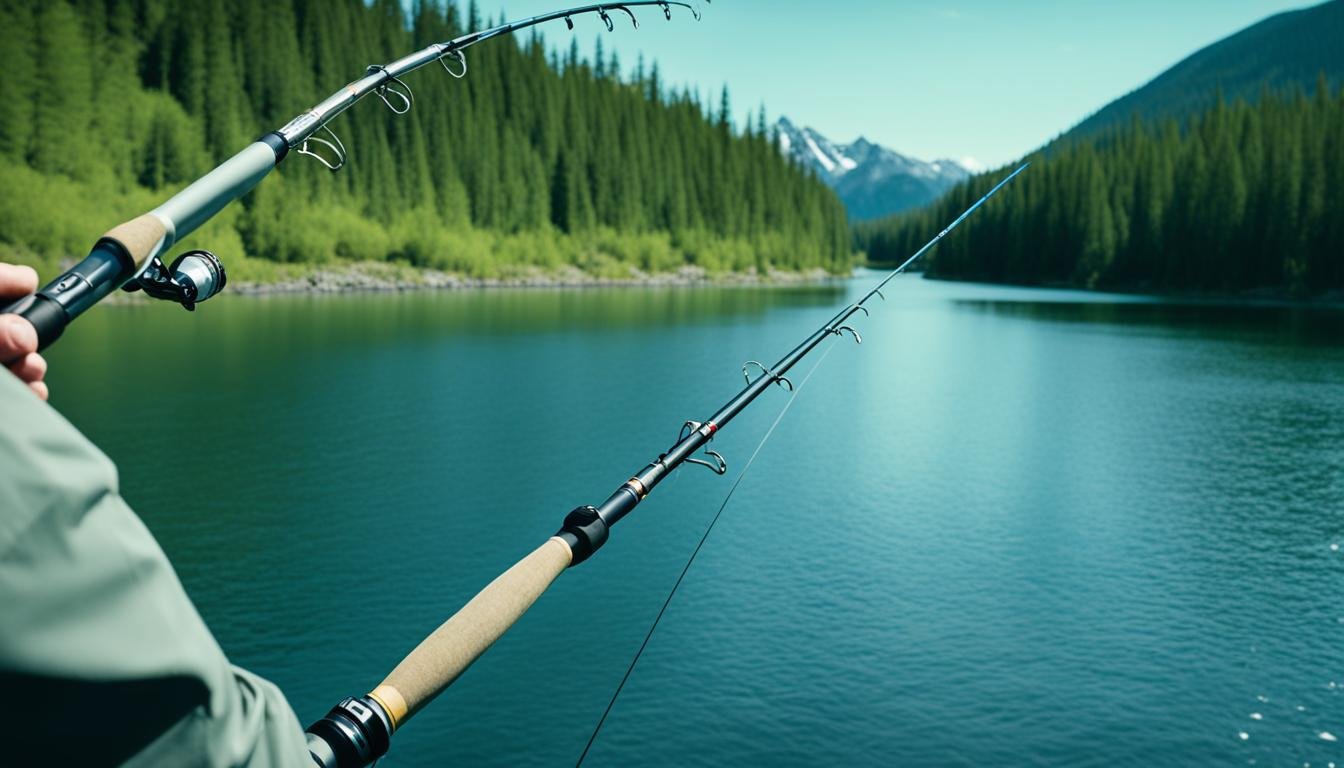Are you an avid angler constantly seeking ways to enhance your fishing success? Look no further than the art of jigging!
This versatile technique has the power to unlock a world of fishing opportunities, allowing you to target a diverse array of species in both saltwater and freshwater environments.
By mastering the various jigging methods, you can significantly improve your catch rates and enjoy more rewarding fishing experiences.
Key Takeaways about Jigging Fishing Techniques
- Jigging is a highly effective fishing technique that involves using a weighted lure to imitate the movement of a wounded baitfish.
- Mastering different jigging techniques, such as vertical jigging and horizontal jigging, can help you target a wide range of fish species.
- Jigging can be employed in both saltwater and freshwater settings, providing you with a versatile fishing approach.
- Understanding the nuances of jigging, from lure selection to presentation, can significantly enhance your fishing success.
- Exploring various jigging techniques and adapting them to your local fishing conditions can open up new opportunities for more consistent and rewarding catches.
Understanding the Basics of Jigging
Jigging is a versatile and dynamic fishing technique that has gained immense popularity among anglers worldwide. This method involves using a weighted lure, known as a jig, and imparting a specific motion to mimic the movements of a struggling baitfish. The strategic movements and presentations of the jig are crucial in attracting and enticing fish to strike.
What is Jigging?
Jigging is a fishing technique that involves actively manipulating the lure to create an erratic, life-like action. Anglers can achieve this by utilizing various rod movements, such as lifting, dropping, or sharply twitching the rod, causing the jig to swim, dart, or flutter in the water. The goal is to replicate the natural behaviors of a wounded or distressed prey, which can trigger a predatory response from the target fish.
Different Types of Jigging Techniques
There are several distinct jigging techniques that anglers can employ, each suited for different fishing conditions and target species. These include:
- Vertical Jigging: This involves a straight up-and-down motion of the jig, often used in deeper waters to target species like grouper, snapper, and tuna.
- Horizontal Jigging: This technique involves a side-to-side or figure-eight motion, which can be effective for species that inhabit shallower waters, such as striped bass and bluefish.
- Slow Pitch Jigging: This method utilizes a slower, more controlled lift-and-drop motion, making it ideal for bottom-dwelling species like sea bass, porgy, and cod.
- High-Speed Jigging: This fast-paced technique involves quick, aggressive movements of the jig to target pelagic species like tuna, wahoo, and mahi-mahi.
Mastering these various jigging techniques can help anglers effectively target a wide range of fish species in diverse fishing environments, from deep offshore waters to shallow inshore areas.
Jigging Fishing Techniques

Jigging is a versatile fishing technique that offers anglers a diverse range of opportunities, whether they’re targeting saltwater or freshwater species. Two of the most prominent jigging methods are vertical jigging and horizontal jigging, each with its own distinct advantages and applications.
Vertical Jigging
Vertical jigging involves using quick, up-and-down motions with the rod to create an erratic, frenzied movement of the jig. This technique is often employed in saltwater environments to target species that lurk in deeper waters, such as tuna, cobia, and mackerel. The vertical jigging motion mimics the behavior of a wounded baitfish, drawing the attention of these predatory fish.
Horizontal Jigging
In contrast, horizontal jigging involves a more subtle, side-to-side motion of the jig. This technique can be effective for targeting bottom-dwelling species in both saltwater and freshwater environments. The horizontal jigging motion is designed to imitate the natural swimming pattern of small prey, attracting fish that are hunting near the seafloor or riverbed.
Both vertical jigging and horizontal jigging techniques require a certain level of skill and practice to master. However, the rewards can be substantial, as these jig fishing techniques allow anglers to target a wide variety of species in diverse fishing scenarios.
“Jig fishing is described as not being the easiest technique and involves a certain level of skill and know-how, suggesting that it’s a technique that requires practice and mastery.”
The choice between vertical and horizontal jigging often depends on the specific fishing conditions, the targeted species, and the angler’s personal preference. By understanding the nuances of these two fundamental jigging techniques, anglers can adapt their approach to maximize their chances of success and enjoy a more rewarding jig fishing experience.
Mastering the Art of Tight Line Jigging

When it comes to jigging techniques, tight line jigging, also known as “dead stick” jigging, stands out as a highly effective method, particularly in cold water conditions. This approach involves lowering the jig to the bottom and holding the rod still as the boat drifts, allowing the natural rocking motion of the water to provide the necessary action.
Dead Stick Jigging
Dead stick jigging is particularly effective when fish are less active and prefer a slower, more subtle presentation. By keeping the rod still and letting the jig rest on the bottom, anglers can tempt even the most finicky fish to strike. This technique is especially useful for targeting walleye in rivers, where the challenge of mastering jigging is often described as a test for the average angler.
Slack Line Jigging
Slack line jigging is a variation of tight line jigging, where the angler allows the jig to sink quickly and crash the bottom before lifting it back off the bottom on a taut line. This technique can be particularly effective in cold water conditions, as it simulates the natural movement of baitfish and triggers predatory instincts in fish.
Both tight line jigging and slack line jigging require precise presentation and a keen understanding of fish behavior. Anglers who master these techniques can enjoy greater success in cold water jigging and bottom fishing scenarios, as they are able to effectively present their lures in a way that resonates with the target species.
“Mastering the art of tight line jigging is a game-changer for anglers looking to up their cold water fishing game. The subtle, deliberate presentation of the lure is often the key to enticing even the most finicky fish to strike.”
By incorporating these tight line jigging and slack line jigging techniques into their arsenal, anglers can unlock new levels of success in their bottom fishing and cold water jigging adventures.
Aggressive Jigging Techniques
As water temperatures rise, anglers can employ more aggressive jigging techniques to entice strikes from active fish species. One effective approach is known as “popping” the jig off the bottom by quickly snapping the rod tip. This causes the jig to jump up and then sink back down, creating an alluring “hop” that can trigger a reaction strike.
The key to successful aggressive jigging is to avoid being too heavy-handed. While the sudden upward motion of the jig can be effective, it’s important not to take the lure out of the fish’s strike zone for too long. Striking the right balance between an aggressive presentation and maintaining the jig’s presence in the water column is crucial for maximizing your chances of hooking up.
Experienced anglers often experiment with different jigging cadences and rhythms to find what works best for the target species and the prevailing conditions. Studying fish behavior and observing their reactions to various jigging techniques can provide valuable insights to refine your approach. By adapting your jigging style to the situation at hand, you can unlock the full potential of this versatile and effective fishing method.
“Aggressive jigging can be a game-changer when the fish are in a feisty mood, but it’s essential to find the sweet spot between a dynamic presentation and keeping the lure in the strike zone.”
Whether you’re targeting walleye, trout, or other species, incorporating aggressive jigging techniques into your arsenal can lead to more successful and exciting fishing adventures. By mastering the art of “popping” and “hop” jigging, you’ll be well on your way to consistently landing more fish and enjoying a more rewarding fishing experience.
Gear for Jigging

Selecting the right gear is crucial for successful jigging. From the fishing rod to the line, every component plays a vital role in transmitting those subtle bottom movements and strike indications to the angler. Let’s dive into the key considerations when gearing up for jigging.
Fishing Rods for Jigging
When it comes to jigging rods, most enthusiasts prefer a rod with a faster action over a slower one. The length range typically varies from six feet to seven and a half feet, with higher-end rods often featuring guides with inserts to reduce friction and line wear, such as the Fuji SiCs. Spinners are favored by most anglers over baitcasters due to their ease of use and higher line capacity.
Fishing Lines for Jigging
The general preference for fishing line in jigging is braid in the 20-30 pound test range. Including a short length of mono or fluorocarbon leader in the 20-30 pound range is a common practice to increase abrasion resistance. A reel with a smooth drag is essential when tackling fish heavier than the line’s pound-test to prevent line breakage.
When selecting jigging lures, paddletails like Bloody Point Baits’ Shad or BKDs are popular choices. Jigging gear selection is a personal choice, with various factors like sensitivity, longevity, and price influencing decisions.
“Jigging is particularly effective for catching species such as Marlins, Amberjacks, Groupers, and Swordfish.”
The right combination of jigging rods and lines can make all the difference in your fishing success. By understanding the nuances of these critical components, you’ll be well on your way to mastering the art of jigging and reeling in your dream catch.
Targeting Different Species with Jigging

Jigging is a versatile fishing technique that can be effectively employed to target a wide array of species in both saltwater and freshwater environments. By understanding the preferred habitats and feeding behaviors of different fish, anglers can optimize their jigging approaches to improve their catch rates.
Saltwater Jigging Targets
In the saltwater realm, popular jigging targets include pelagic species such as tuna, cobia, and mackerel, as well as bottom-dwelling species like grouper and snapper. These fish are often found in areas with strong currents or near underwater structures, and they can be enticed by the erratic movement of a well-presented jig. Anglers can employ vertical jigging techniques to target these saltwater species effectively.
Freshwater Jigging Targets
Freshwater anglers can also capitalize on the power of jigging to target a variety of species, including bass, crappie, salmon, trout, and walleye. These fish may be found in a range of habitats, from deep, vertical structure to shallow, mid-depth cover. Jigging techniques, such as horizontal jigging or tight-line jigging, can be tailored to the specific preferences of the target species and the prevailing conditions.
| Saltwater Jigging Targets | Freshwater Jigging Targets |
|---|---|
| Tuna, Cobia, Amberjack, Mackerel, Grouper, Snapper | Bass, Crappie, Salmon, Trout, Walleye |
By understanding the unique characteristics and behaviors of different fish species, anglers can tailor their jigging techniques and gear selection to maximize their chances of success. Whether targeting saltwater or freshwater species, the versatility of jigging makes it a valuable tool in the arsenal of any dedicated angler.
“Jigging can be an incredibly effective way to target a wide variety of species, both in saltwater and freshwater environments. The key is to understand the specific feeding and habitat preferences of the fish you’re after and then adapt your jigging technique accordingly.”
Choosing the Right Jigging Location
Selecting the ideal jigging location is a crucial aspect of successful angling. Savvy anglers understand that the location and structure of the water body play a pivotal role in determining where predatory fish are likely to congregate and feed. By honing in on these strategic jigging spots, anglers can dramatically improve their chances of landing trophy catches.
One of the key factors to consider when choosing a jigging location is the presence of irregular bottom features, such as drop-offs, ledges, and submerged structures. These areas often serve as natural hotspots for baitfish, which in turn attract larger predatory species that anglers target with jigging techniques. By focusing their efforts on these prime jigging locations, anglers can capitalize on the natural tendencies of their target fish.
In addition to bottom structure, the jigging depth is another critical factor to consider. The depth of the water will dictate the weight and style of jig that is most effective for the conditions. Deeper waters may require heavier jigs to reach the optimal jigging depth, while shallower areas may call for lighter, more finesse-oriented presentations. Paying close attention to the jigging depth and matching it with the appropriate gear can be the difference between a successful day on the water and a frustrating one.
By combining an understanding of prime jigging locations, jigging spots, and jigging depth, anglers can unlock the secrets to consistent, high-quality catches. Whether targeting saltwater species or freshwater gamefish, mastering the art of choosing the right jigging location is a surefire path to angling success.
Tips for Successful Jigging
Mastering the art of jigging fishing takes time and practice, but there are several tips that can help anglers improve their success. Maintaining a tight line and staying in constant contact with the jig is crucial, as it allows you to feel the subtle bites and react quickly when a fish strikes. Being prepared to set the hook decisively is also key, as fish often strike the jig aggressively.
Experimentation is another important aspect of successful jigging techniques. Try different jig sizes, shapes, and colors to find what the fish are responding to on a given day. Paying close attention to the feel of the jig hitting the bottom and any subtle strikes is also critical for becoming a skilled jig fisherman.
When it comes to jigging presentation, consider the water clarity and light conditions, as these can significantly impact the color and action of your jig. In clear water, for example, a more subtle and natural presentation may be more effective, while in murky water, a bolder color and more aggressive action may be the key to attracting fish.
Proper boat control is also essential for successful jigging fishing. Maintain a position that allows you to effectively present the jig to the targeted area, and be prepared to make adjustments as the conditions change. Additionally, mapping the bottom and deciphering clues about fish-holding structure can help you identify the most promising spots to focus your efforts.
| Jig Weight Recommendation | Line Breaking Strength | Average Lure Weight | High Lure Weight |
|---|---|---|---|
| 10 Kilo Line | 10 Kilo | 100g | 120g |
Remember, successful jigging fishing is often the result of a combination of techniques, attention to detail, and persistence. By incorporating these tips into your approach, you’ll be well on your way to consistently landing more fish on the end of your line.
“Successful jig fishing is directly proportional to the time and effort invested. The 80:20 rule is particularly true in jig fishing, suggesting that 80% of the results come from 20% of the efforts.”
Jigging Fishing Techniques
Jigging is a versatile and effective fishing technique that can be used to target a variety of species in both saltwater and freshwater environments. By mastering different jigging techniques, anglers can improve their catch rates and enjoy more successful fishing trips. From vertical jigging to horizontal jigging, tight line jigging to aggressive jigging, each approach offers unique advantages and requires specific skill sets.
One of the key benefits of jigging is its ability to mimic the natural movements of prey, which can trigger a feeding response in predatory fish. By carefully controlling the cadence, rhythm, and presentation of the jig, anglers can entice even the most finicky fish to strike. Whether targeting saltwater species like Chinook salmon or freshwater favorites like Bluegill, jigging techniques can be tailored to the specific needs of the target species and their habitat.
Selecting the right gear is also crucial for successful jigging. Anglers need to choose the appropriate fishing rods, reels, lines, and jigs to match the specific conditions and target species. Strong rods, high-quality reels with smooth drag systems, and durable lines are all essential for handling the physical demands of jigging, especially when targeting larger, more powerful fish.
To master the art of jigging, anglers must also understand the different types of jigging techniques and when to employ them. Vertical jigging involves lifting the jig up and down in a straight line, while horizontal jigging incorporates a side-to-side or figure-eight motion. Tight line jigging and aggressive jigging offer additional variations, each with their own unique advantages depending on the target species and fishing conditions.
By combining the right gear, understanding the habitat and behavior of the target species, and mastering a variety of jigging techniques, anglers can unlock the full potential of this versatile and effective fishing method. Whether you’re targeting Walleye, Bass, or any other species, jigging can be a powerful tool in your angling arsenal.
“Jigging is not just a technique, it’s an art form. To truly master it, you have to understand the nuances of the fish, the conditions, and the presentation of the jig itself.”
Conclusion
As we’ve explored, jigging fishing is a powerful and versatile technique that can unlock a world of successful and rewarding fishing experiences. Whether you’re targeting bass, walleye, trout, or a variety of saltwater species, mastering the art of jigging can significantly boost your catch rates and provide an unparalleled sense of excitement when a fish strikes your jig.
From understanding the different jigging approaches to selecting the right gear and understanding the ideal fishing locations, this guide has equipped you with the knowledge and skills to take your jigging fishing to new heights. By applying these techniques and tips, you’ll be able to adapt to diverse fishing conditions and become a more well-rounded angler, capable of utilizing both jigging and trolling methods to achieve consistent and thrilling results.
So don’t hesitate to put these jigging fishing techniques into practice, whether you’re casting from the shore or working a jig from your boat. With patience, perseverance, and a willingness to experiment, you’ll soon be reeling in impressive catches and creating lasting memories on the water. Happy jigging, fellow anglers!
FAQ about Jigging Fishing Techniques
What is jigging in fishing?
Jigging is a fishing technique that involves using a weighted lure, or jig, and imparting a specific motion to the lure to mimic the movements of a struggling baitfish.
What are the different types of jigging techniques?
The main types of jigging techniques include vertical jigging, horizontal jigging, slow pitch jigging, and high-speed jigging. Each technique has its own unique set of motions and is suited for different fishing situations and target species.
What is the difference between vertical jigging and horizontal jigging?
Vertical jigging involves quick, up-and-down motions with the rod to create an erratic, frenzied movement of the jig, while horizontal jigging involves a more subtle, side-to-side motion of the jig.
What is tight line jigging and how is it effective?
Tight line jigging, also known as “dead stick” jigging, involves lowering the jig to the bottom and holding the rod still as the boat drifts, allowing the natural rocking motion of the boat to provide the necessary action. This technique is particularly effective in cold water conditions when fish are less active and prefer a slower, more subtle presentation.
What is the difference between tight line jigging and slack line jigging?
Slack line jigging is a variation of tight line jigging where the angler allows the jig to sink quickly and crash the bottom before lifting it back off the bottom on a taut line.
What is “popping” or “hop” jigging and when is it effective?
As water temperatures rise, more aggressive jigging techniques like “popping” or “hop” jigging can become effective. This involves quickly snapping the rod tip to cause the jig to jump up and then sink back down, which can trigger strikes from more active fish species.
What kind of gear is best for jigging?
A sensitive, lightweight graphite rod with a fast action is ideal for jigging, as it allows anglers to feel subtle bottom and strike indications. Low-stretch lines like braided line or fluorocarbon leaders are also recommended, as they transmit those subtle movements and strikes more effectively.
What species can be targeted with jigging techniques?
In saltwater, popular jigging targets include tuna, cobia, amberjack, mackerel, and various grouper and snapper species. In freshwater, anglers can use jigging techniques to target bass, crappie, salmon, trout, and walleye, among others.
What are the key factors for successful jigging?
Maintaining a tight line and staying in constant contact with the jig, being prepared to set the hook quickly when a fish strikes, and experimenting with different jig sizes, shapes, and colors to find what the fish are responding to on a given day are all important factors for successful jigging.
Source Links
- https://mackslure.com/blogs/mack-attack/ice-fishing-how-to-locate-fish-and-effective-jigging-techniques – Ice Fishing: How to Locate Fish and Effective Jigging Techniques
- https://in-fisherman.com/editorial/pike-jigging-strategies/154661 – Pike Jigging Strategies – In-Fisherman
- https://www.nzfishingworld.co.nz/posts/a-beginners-guide-to-jigging – A beginner’s guide to jigging
- https://www.oceanbluefishing.com/magazine/jigging-basics/ – Jigging 101: Your Ultimate Guide to Jigging [BLOG 2019]
- https://www.northlandtackle.com/jig-fishing-101/ – Jig Fishing 101 | Northland Fishing Tackle
- https://onthewater.com/slow-pitching-jigging-101 – Slow Pitch Jigging 101 – On The Water
- https://captainexperiences.com/blog/fishing-techniques-the-beginners-guide-to-jigging – Fishing Techniques: The Beginner’s Guide To Jigging
- https://www.hukgear.com/blogs/news/jig-fishing-techniques – Jig Fishing Techniques Every Angler Should Know
- https://fishingbooker.com/blog/jig-fishing/ – How to Go Jig Fishing: The Complete Guide
- https://woods-n-waternews.com/2023/03/01/be-better-at-jigging/ – BE BETTER AT JIGGING
- https://www.hookedonlurefishing.com/post/shore-jigging – Shore Jigging
- https://www.ryanmoodyfishing.com/what-is-slow-pitch-jigging/ – What Is Slow Pitch Jigging? – Ryan Moody Fishing
- https://www.joelnelsonoutdoors.com/ask-me-anything/2018/10/25/how-to-fish-a-jigging-rap-eekhz – Jigging Rap Tips and Tricks — Joel Nelson Outdoors
- https://www.glangler.com/blogs/articles/power-jigging-walleyes-by-matt-straw – Power Jigging Walleyes by Matt Straw
- https://islandfishermanmagazine.com/twitching-hopping-and-jerking-jigs-like-a-rockstar – Twitching, Hopping, and Jerking Jigs like a Rockstar – Island Fisherman Magazine
- https://www.fishtalkmag.com/blog/gearing-part-iii-choosing-ideal-jigging-gear – Gearing Up Part III: Choosing the Ideal Jigging Gear
- https://wonews.com/speedjigginghowto/ – Speed jigging for bluefin tuna – expert tactics, tackle and tips
- https://www.coastalfishing.com/blogs/saltwater-fishing-101/jigging-fishing-the-ultimate-guide – Jigging Fishing Like A Pro: The Ultimate Jigging Guide
- https://www.thefisherman.com/article/snap-it-on-the-beach-how-to-snap-jigging-from-shore/ – “Snap It” On The Beach: How To Snap-Jigging From Shore – The Fisherman
- https://www.wired2fish.com/fishing-tips/fishing-a-jig-and-minnow-throughout-the-summer – Fishing a Jig and Minnow Throughout the Summer
- https://www.omniafishing.com/a/mastering-the-jigging-spoon – Mastering the Jigging Spoon: The Ultimate Guide to Targeting Diverse Fish Species
- https://www.sportfishingmag.com/story/gear/jigging-tackle-buyers-guide/ – How to Pick Tackle for Jig Fishing | Sport Fishing Mag
- https://www.saltwatersportsman.com/gear/slow-pitch-jigging-tackle/ – How to Choose Slow-Pitch Jigging Tackle | Salt Water Sportsman
- https://www.outdoorcanada.ca/jig-fishing-for-walleye/ – 5 top jig-fishing tactics for walleye • Outdoor Canada
- https://www.joelnelsonoutdoors.com/blog/2018/6/5/the-keys-to-successful-jig-fishing – The Keys to Successful Jig Fishing — Joel Nelson Outdoors
- https://www.in-fisherman.com/editorial/10-steps-to-better-jigging/155036 – 10 Steps to Better Jigging – In-Fisherman
- https://www.bishfish.co.nz/articles/salt/jiggingtips.htm – How to catch more fish on jigs
- http://webpeche.owally.com/jigging_technique/jigging_technics.html – Jigging technique – (Speed and Slow)
- https://smoothmovesseats.com/blog/what-types-of-fish-can-you-catch-with-jigging/ – What Types of Fish Can You Catch With Jigging?
- https://fishncanada.com/5-walleye-jigging-techniques-you-need-to-know/ – 5 Walleye Jigging Techniques You Need To Know – Fish’n Canada
- https://www.glidesup.com/blogs/expert-advice/jig-fishing-101-a-beginners-guide-to-this-effective-fishing-technique – Jig Fishing 101: A Beginner’s Guide to This Effective Fishing Techniqu
- https://blog.baityourhook.com/fishing-101-a-beginners-guide-to-jigging/ – Fishing 101: A Beginner’s Guide to Jigging
- https://mackslure.com/blogs/mack-attack/trolling-vs-jigging-tips-and-techniques – Tip & Techniques: When To Troll vs. When To Jig


